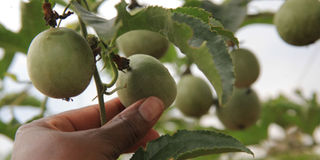Pick more cash from passion fruits

Regularly weed the field to remove unwanted plants which may act as hosts for diseases such as mosaic viruses. It also minimises nutrient competition among plants. Pruning in passion fruits is done to remove overgrown growth.
Most farmers are embracing high horticultural value crops such as passion fruits and avocados, ditching crops with unreliable market such as maize, sugarcane and beans.
According to Julius Ahagaana, a passion fruit agronomist, one hectare of land can yield 15 to 20 tonnes of the produce, enough to earn farmers up to Shs40m.
Passion fruit farming starts with an establishment of an orchard, which ensures a strong crop stand that withstands environmental stress.
The crop does well in regions with rainfall of over 1200mm, well distributed throughout the year. Irrigation is recommended in areas with rainfall levels below 1200mm.
The soil
Before cultivating, examine the soil for type, texture, depth, chemical analysis, nutrient and nematode levels. Light to heavy sandy loams of medium texture with good drainage are most suitable.
Passion fruits do well in a pH range of 5.5 – 6.5. “Soil testing costs Shs50,000 per sample, in this we test the nutritional analysis, pH, organic carbon matter and the results are normally out in two days,” Nick Onyango, an officer at SoilCares Ltd, a company that monitors and analyses soil fertility, says.
Land preparation
Land preparation is done two to three months before planting with hard pan within 80cm being broken.
Planting
At planting, make holes measuring 45cm wide and 45cm deep spaced at 1.8m between plants and two metres between rows.
Manure
Apply at least 10 kilogrammes of well rotten manure to the plants and mix with the soil.
Phosphates
Apply 125 grammes or triple super phosphate (TSP) or diammonium phosphate (DAP) per hole.
Top dressing
Two weeks after planting, apply calcium ammonium nitrate (CAN) at the rate of 125 grammes per plant.
Weeding
Regularly weed the plants to remove unwanted plants which may act as hosts for diseases such as mosaic viruses. It also minimises nutrient competition among plants.
Supporting structure
Since passion fruit is a climber, the plant needs support. In this, dig holes to a depth of 50cm with a spacing of six metres apart along the passion seedling rows. Use poles with a height of 2.7m long.
Pruning
Pruning in passion fruits is done to remove overgrown growth and keep the vines under control. It encourages new growth through removal of weak and dead parts. This eases pest and disease management.
Exports
According to Ahagaana the demand for the fruit in the local and international market is still unmet.
Uganda can export the fruit to Brazil, Colombia, Zambia, Zimbabwe, Holland, France, United Kingdom, United Arab Emirates, Germany and Belgium. Passion fruits are very rich in Vitamins A and C and carotene making it an important health food. The fruit is also used for commercial juice processing.




